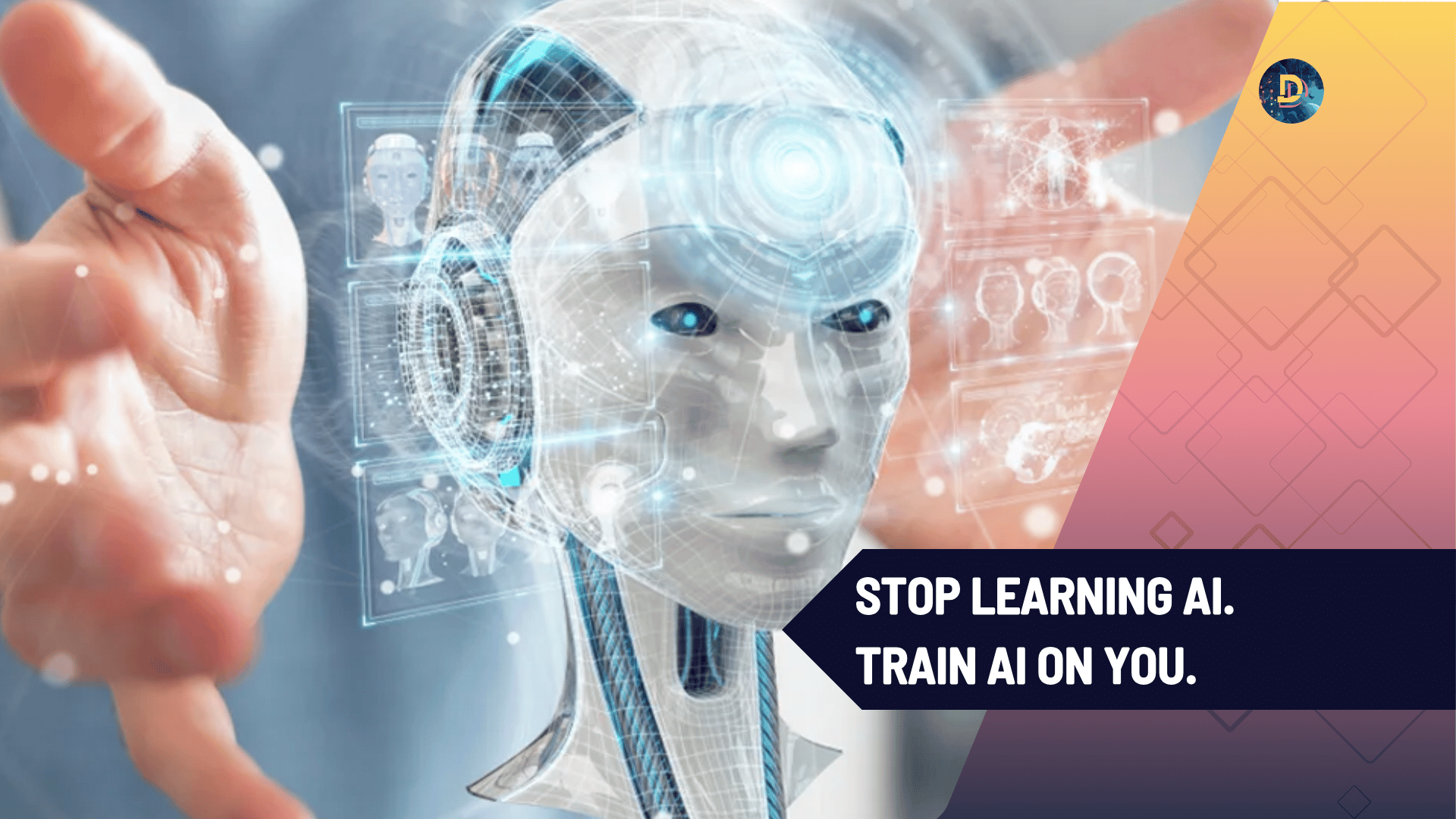AI That Thinks Like You Wins. AI That Automates You Fails.
tl;dr
Mastering AI as a Thinking Partner: Executives are encouraged to train AI on their unique thinking processes rather than merely learning how to use AI tools. This approach scales their strategic expertise and decision-making, positioning AI as an extension of their intelligence.
Personalized AI Advantage: By teaching AI their specific style, reasoning, and workflows, leaders can leverage AI to enhance decision-making, identify blind spots, and increase overall effectiveness.
Beyond Automation: The focus is on creating AI-human partnerships that amplify strategic insights and drive competitive advantage, rather than just automating tasks.
72% of U.S. businesses are using AI. In Canada, that number drops to 33%. The gap is real. The real trap? Most companies use AI wrong. They treat it like a virtual assistant instead of an unfair advantage.
Don’t follow the pack using AI to generate emails and reports that sound like everyone else’s. Don’t measure the success of AI integration only in terms of productivity gain.
Join the Executive AI Mastermind. Engage with fellow leaders mastering AI as an essential partner. Make AI apply, beyond writing emails faster. Prepare for a world where choosing between AI and human talent requires new approaches to leading. Thursdays 12pm PST/ 3pm EST. ONE MONTH FREE for Disruption readers!
The real play? Stop learning AI. Train AI on you.
How do you pull ahead? What if the goal isn’t to train people on AI, but to train AI on your best people? Most leaders treat AI like outsourcing instead of intelligence. They see it as a way to automate tasks, and go hunting for the best tools or platforms.
The problem is those making decisions are not using it to enhance their own thinking and way of work. That means there is no way their teams will. It’s like calling your company data-driven when what you know is pivot tables. And the potential is endless.
Most businesses struggle with AI adoption because they see it as a tool for automation instead of an extension of their intelligence. They use it to write generic reports, summarize meetings, and generate to-do lists—without realizing that AI, when trained properly, can scale their unique expertise.
Here’s why it matters: AI that imitates your thinking doesn’t just make work faster; it makes work smarter. Instead of copying generic industry standards, it reinforces your strategic edge.
Imagine:
A CEO having AI query her on her risk tolerance and decision making? She trains AI to evaluate investment opportunities using her personal risk assessment framework. The result? Faster, smarter decisions while sharpened insight from AI.
A sales leader training AI for outbound sales to qualify leads based on his best sales peoples’ scripts, increasing reach while improving conversion rates without relying on rigid, one-size-fits-all CRM filters. AI and human sales people become ADDITIVE to each other not replacements.
A consultant using AI deep research to analyze client challenges, getting the data needed to determine actions and to reverse engineer a success state without the “training” the consultant time. The combination of AI and human brain delivers.
When AI mirrors your best thinking, it doesn’t replace you. It scales you.
Stop Investing in AI Trainings - Teach AI About YOU
Instead of chasing certifications and AI programs to train you, focus on:
Teaching AI how you think.
Making it understand your priorities, and value.
Training it to execute and make decisions the way you would.
Architect you
Here’s how to start:
1. Train AI on Your Best Work
Forget generic prompts you collect from Forbes or Linkedin. Instead:
Upload your best reports, strategies, or decision memos into an AI project.
Ask it to analyze your reasoning, format, and approach.
Ask AI to document your thinking process into a set of instructions.
If you use ChatGPT, you can also tell it to "Add to Memory."
Companies that integrate AI effectively don’t just use it to execute tasks - they make it an extension of their strategic process. Take Bridgewater Associates, the world’s largest hedge fund. Founder Ray Dalio built an AI system that mimics his decision-making process to help guide investment strategies. Dalio fed the AI decades of his memos, investment strategies, and decision logic, training it to think like he does. The result? A system that can recommend investment moves based on the same principles he would use, even when he isn’t making the call himself.
The takeaway: Train AI on your expertise so it scales what makes you exceptional.
I used it to develop a system so that I could write 5 best selling books in 5 months. The first book took 72 hours, the others 48.
2. Make AI Speak Your Language
AI-generated writing often feels generic because it hasn’t learned your specific style, tone, and way of thinking. Most people assume AI is a plug-and-play tool for content. The reality is AI needs training, just like a new team member.
Here’s how to make AI an extension of your voice:
Provide samples of your writing - memos, emails, reports.
Ask AI to analyze your syntax, tone, and structure.
Have AI generate a writing guide it can use when assisting you.
This makes AI communicate like you. Yes, it isn’t perfect. Yes, it sometimes might lack heart and soul, but that is where you add YOU.
Example prompt:
"Analyze my writing samples and create a writing guide that captures my tone, sentence structure, and preferred phrases. Use this as a reference whenever I ask you to generate content."
3. Use AI to Make You More Effective
Once AI understands your approach, let it identify your blind spots.
Upload transcripts of meeting notes, ask AI: "Where do you see gaps in my logic? What am I missing?"
Have it analyze your patterns and decision-making bottlenecks.
Let it suggest ways to make you better.
AI can act as your personal strategic advisor, helping you:
✅ Identify blind spots
✅ Improve decision-making speed
✅ Challenge assumptions and biases
The fastest way to get ahead? Use the PhD in your Pocket not just as a tool - but as a co-worker.
Scaling AI the Right Way
Our children become readers when they see us read books.
The same applies to AI in an organization. If leaders want teams to adopt AI, they have to show the way. Otherwise, teams won’t.
AI is only as good as what you feed it. Train it wrong, and you’ll create a bad mirror of yourself instead of an intelligent extension of your thinking. Avoid these mistakes:
Outsourcing AI Mindset
AI replaces repetitive tasks.
AI is a cost-cutting tool.
Focuses on automating work.
Little customization or adaptation.
Creates dependency on external AI models.
Feeding it inconsistent data: If you train AI with contradictory reports, unclear decision memos, or generic content, it won’t know what’s truly important. Curate only your best, most strategic thinking.
Focusing only on past work: AI trained on historical documents alone will get stuck in old patterns. To keep it evolving, regularly refine it with your latest insights, decisions, and feedback.
Neglecting feedback loops: AI needs iterations and refinement. Set a recurring practice - weekly or monthly - to audit and adjust how AI is interpreting your approach.
Once AI works for you, scaling is simple.
Your personal AI workflows become templates for others to adopt.
AI can help teams align faster by mirroring your decision-making structure.
Instead of chasing AI adoption, it becomes an organic extension of how your team works.
The Bottom Line
Stop tracking AI trends. Start making AI work like you. This is how AI becomes applicable.
AI isn’t something you “learn.”
It’s something you make work for you - then scale.
Here’s your next move, for 15 minutes a day.
Training AI to Work Like You
AI rewires how you work.
AI enables 100X iteration and experimentation at 1000% lower cost.
Compresses time between decision and outcome.
Adaptable to team or company specific needs. No more vanilla implementations.
Builds internal capability for better strategic use.
✅ What can I test AI on that I do well?
✅ How can I ask AI how we work together better (aka What should I ask you to so that I got outcome A instead of B)
✅ How can I have AI deliver better results? (aka give it feedback on what did and didn’t work).
AI isn’t just a tool. It’s your competitive advantage - if you train it right.






